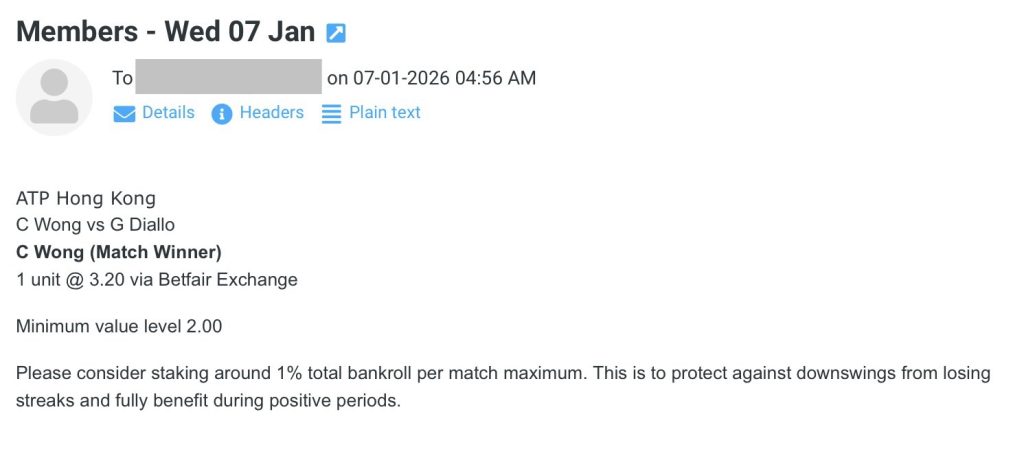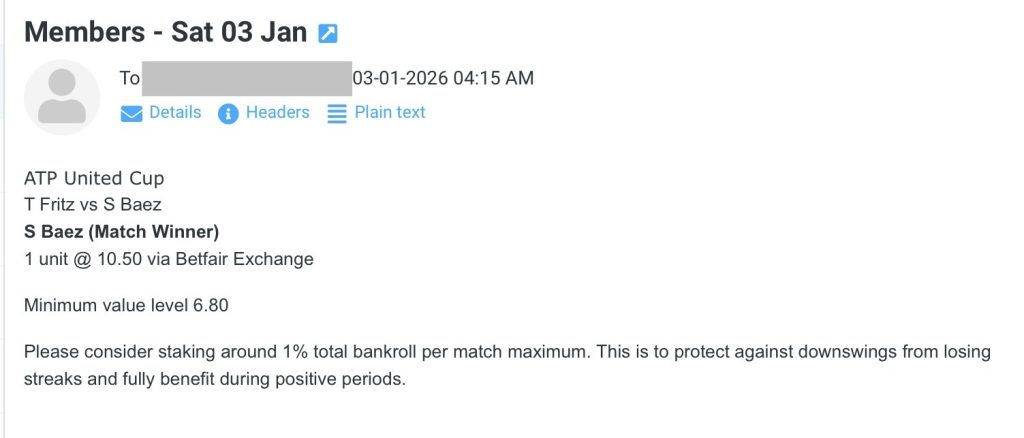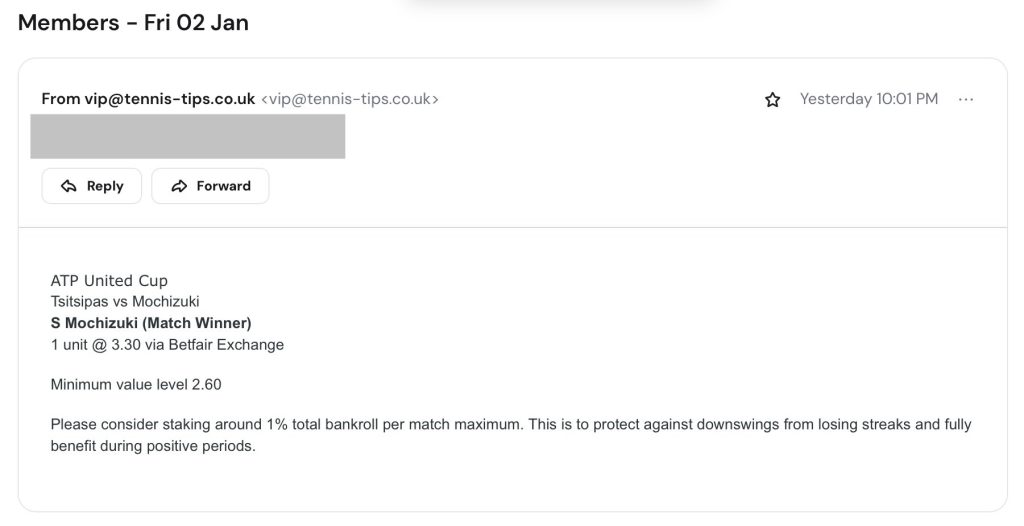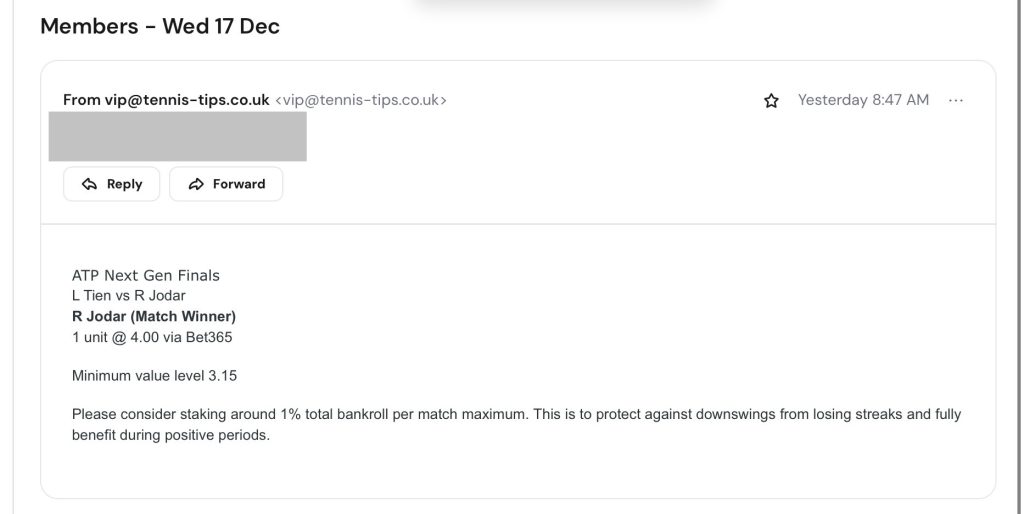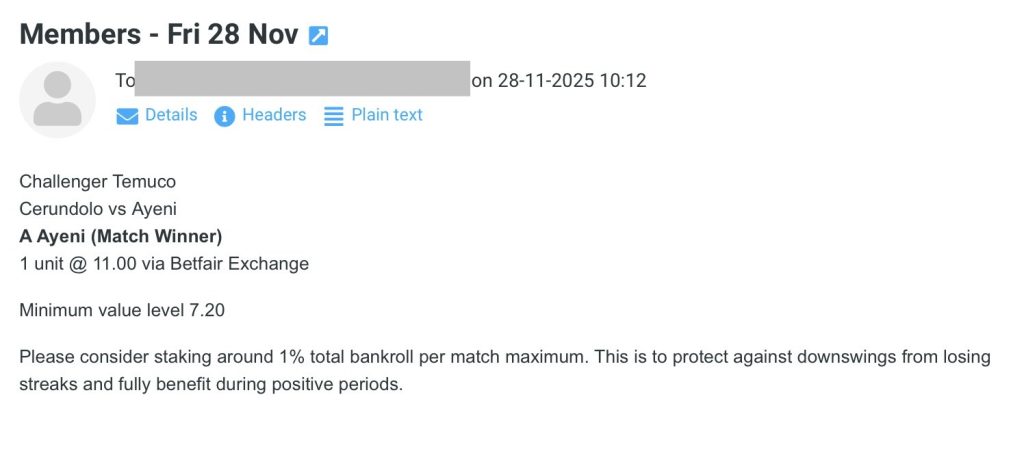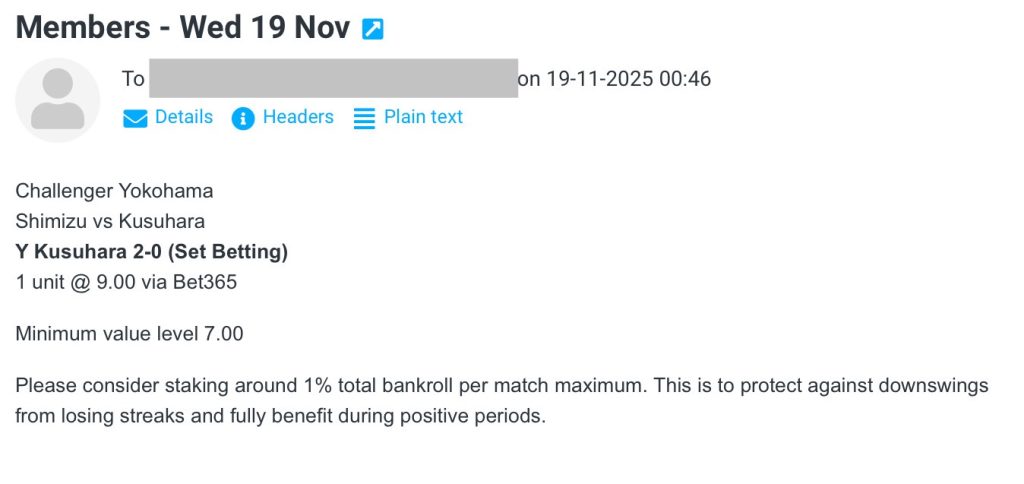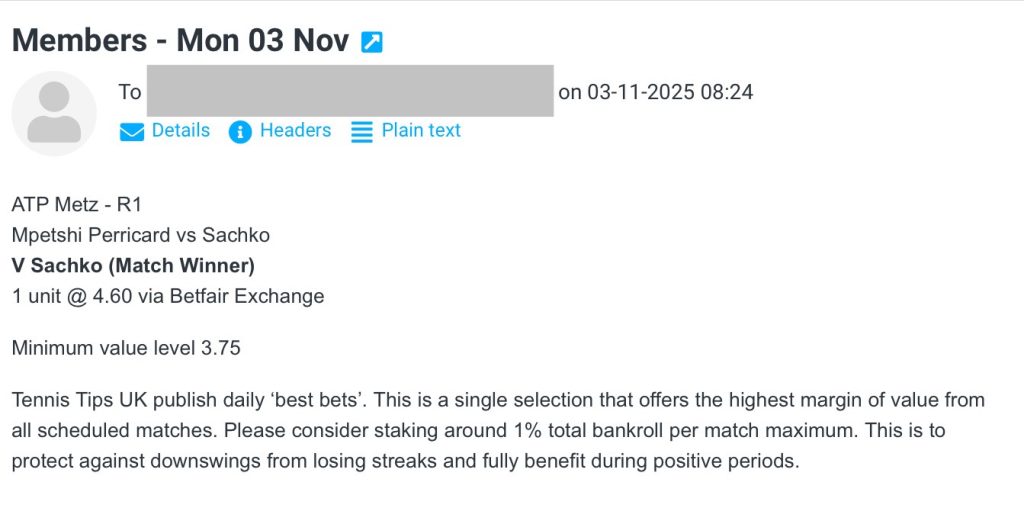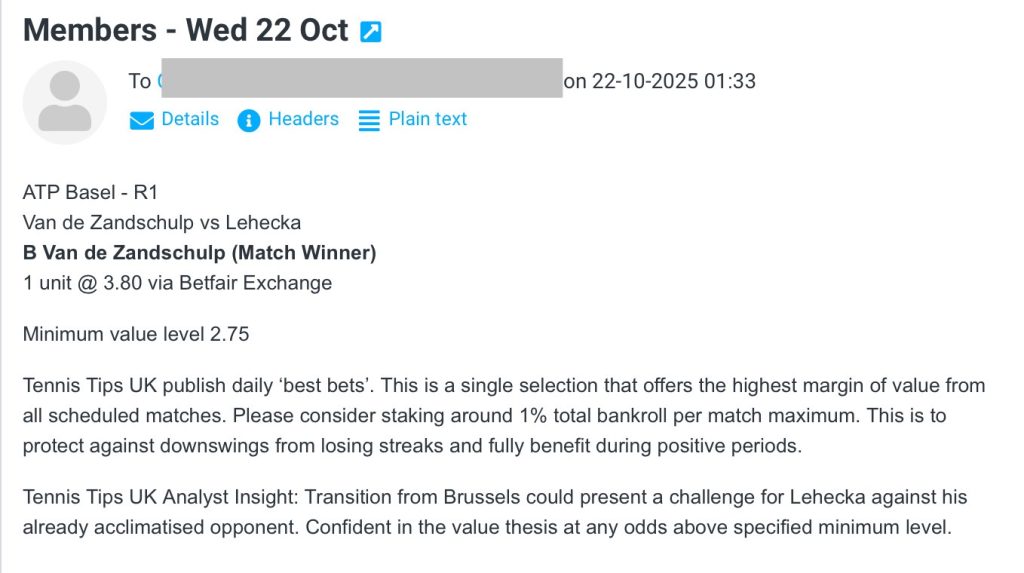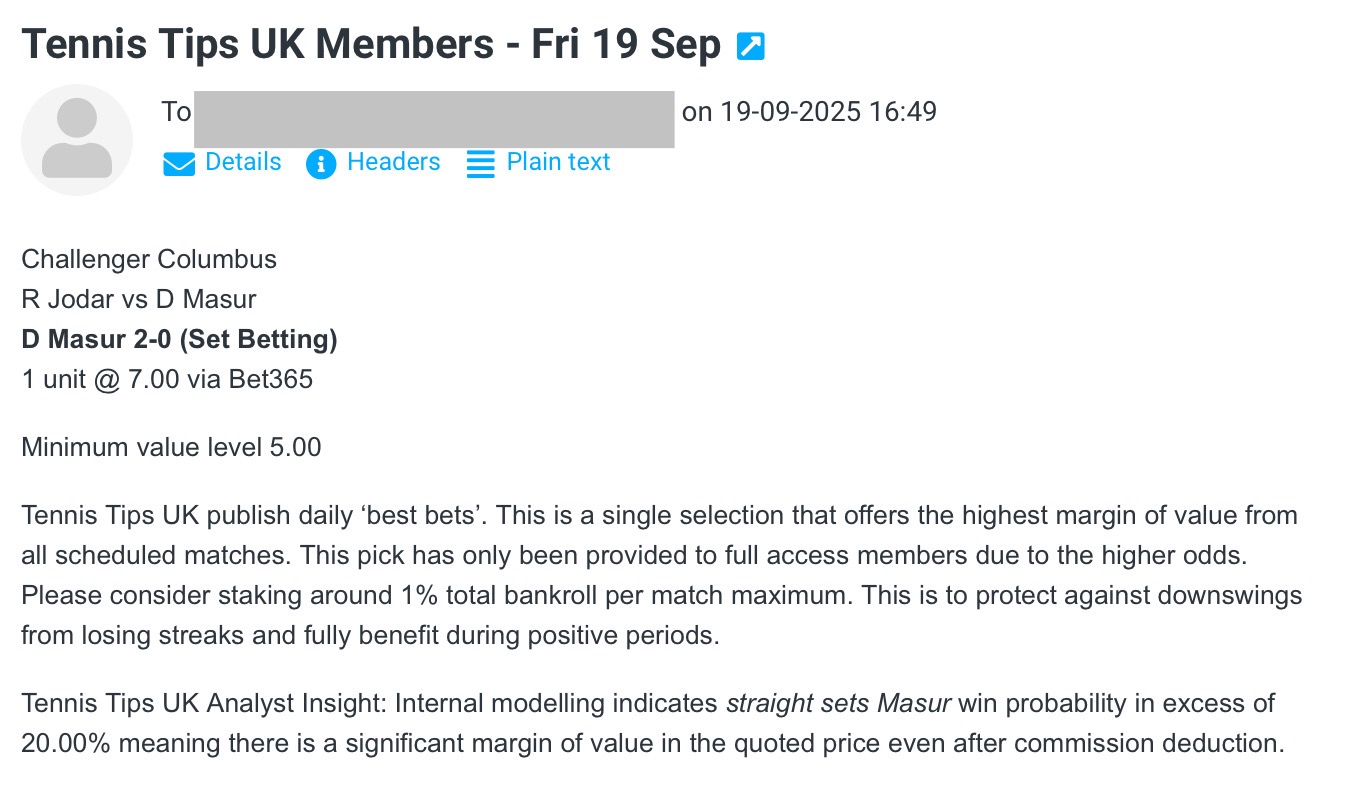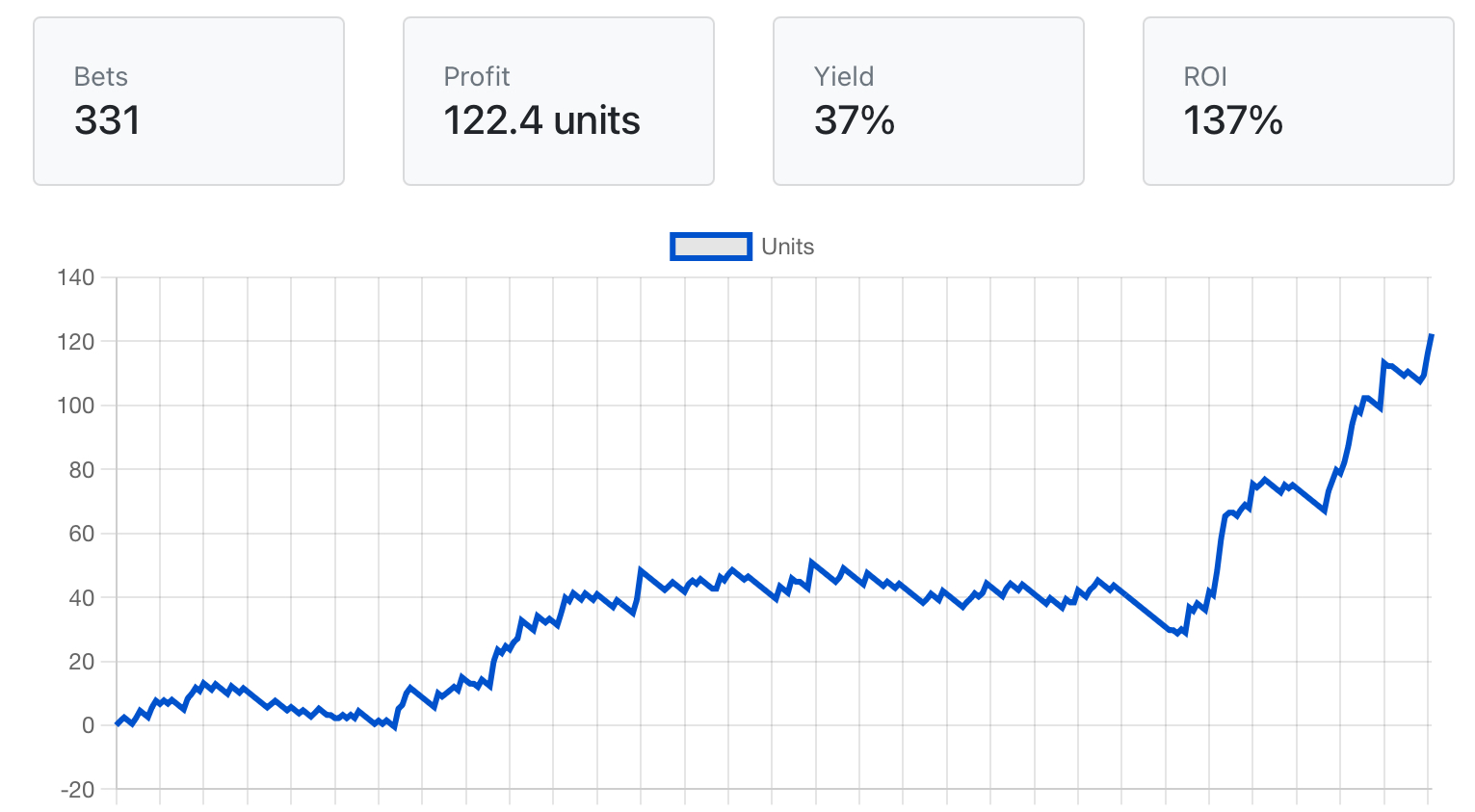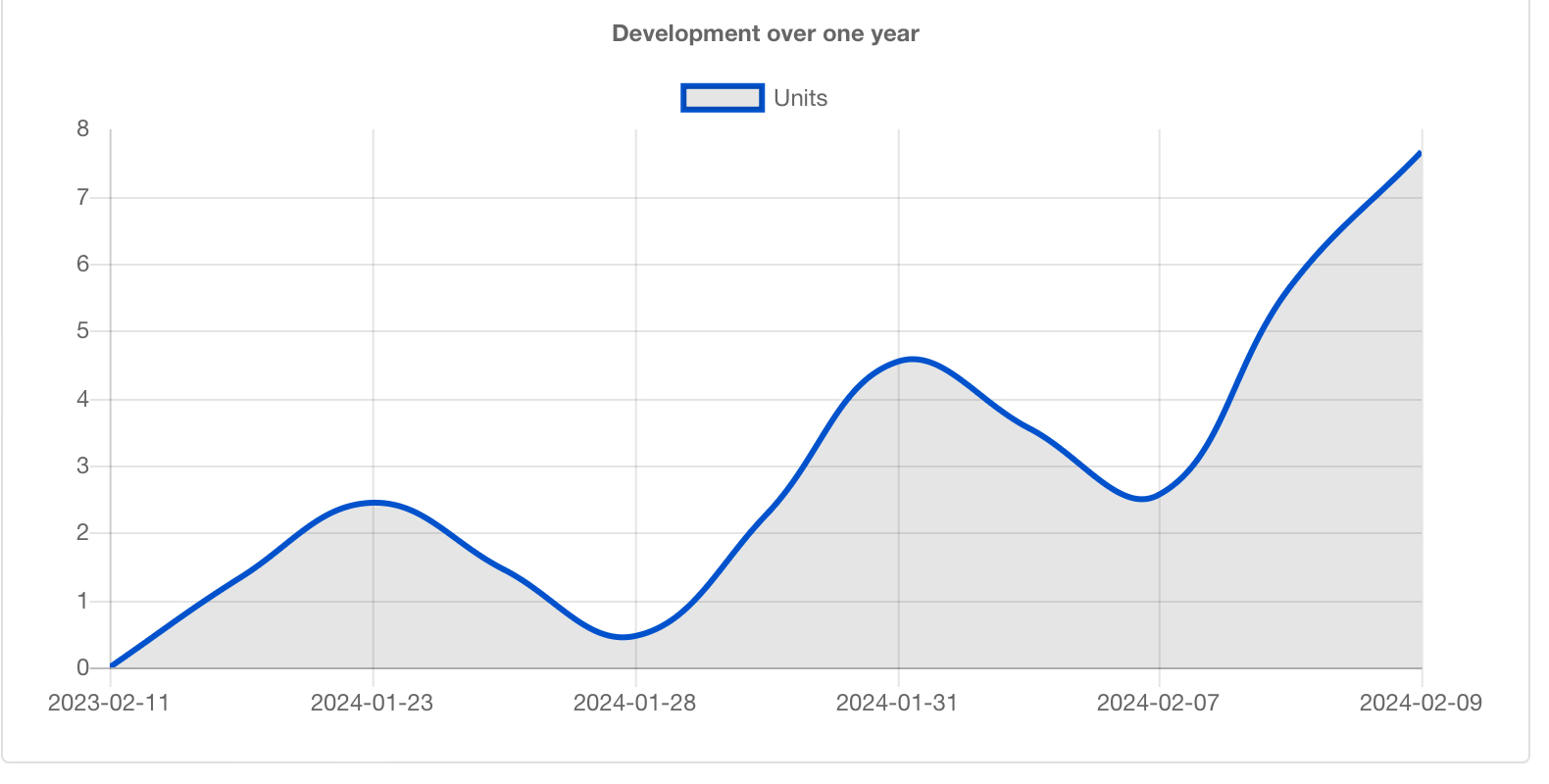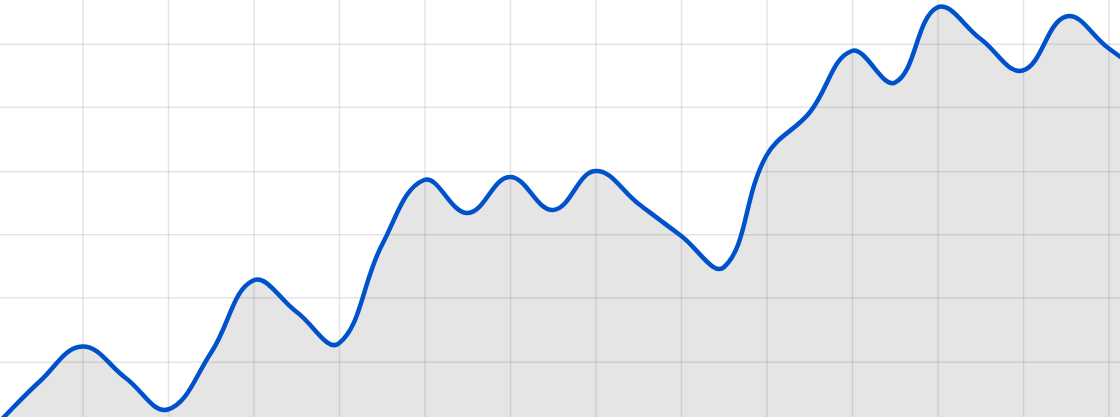Tennis Tips UK have a dedicated team who have operated since 2013. Their job is to analyse all scheduled ATP, Challenger & Grand Slam tennis matches with the objective of identifying the single best bet from across all markets. Club members then receive this direct to their inbox. Strict minimum value thresholds apply so expect around 1-2 picks per week on average. Quality over quantity is a core pillar of their success. Find out more.
| Profit (units) | Yield (%) | Strike Rate (%) | Average Odds (Decimal) | Illustrative Return (£100 staked per pick) |
| +126.20 | 33.80 | 33.30 | 5.05 | £12,620 from backing every selection as of January 2026 |
Latest Members Only Bets
- ✅ WON @ 3.20 | Wong to beat Diallo | ATP Hong Kong
- ✅ WON @ 10.50 | Baez to beat Fritz | ATP United Cup
- ❌ LOST @ 3.30 | S Mochizuki to beat S Tsitsipas | ATP United Cup
- ✅ WON @ 4.00 | R Jodar | ATP Next Gen Finals
- ✅ WON @ 11.00 | A Ayeni | Challenger Temuco
- ✅ WON @ 9.00 | Y Kusuhara 2-0 (Set Betting) | Challenger Yokohama
- ✅ WON @ 4.60 | V Sachko | ATP Metz
- ✅ WON @ 3.00 | U Humbert | ATP Basel
- ✅ WON @ 3.80 | B Van de Zandschulp | ATP Basel
First time member? Enter code: TTUK10 on the sign up page to reduce the cost by 10%. This is strictly available one time for genuine new clients only. There is also the option to pay in Euro (€) or Dollars ($) in which case the same discount will be provided in that currency. The service is completely digital and delivered direct to your registered email inbox. One time payment. No subscriptions or recurring charges.
Are underdogs a viable path to sustained tennis betting profitability?
The appeal of backing underdogs isn’t hard to grasp – in a single wager bankroll can grow significantly – but is this a trap for the greedy and impatient? Should the smart punter grind away gradually with selective favourites and be rewarded for their persistence.
In this article the team have taken a deep dive into the topic of tennis underdogs to provide a definitive and informed answer as to whether underdogs can offer a viable path to sustained tennis betting profitability.
- Initial Problems & Considerations
- Favouritism Bias Thesis
- Indiscriminate Underdog Backing
- Filtering Underdog Markets
Initial Problems & Considerations
Bookmakers apply the highest margins to underdogs. Especially those priced in the 5.00+ range. That mean’s the odds are stacked against punters immediately (in more way than one).
SOLUTION: Sports betting exchanges can help resolve this issue as, for larger matches, the pay-out percentage is close to 100% even for underdogs with just the commission to consider. There is often decent liquidity for ATP tour or higher events. Examples include Betfair, Smarkets & Matchbook. This also allows punters to avoid bookmaker winner limitations and account restrictions.

Favouritism Bias Thesis
It’s well documented that most people back favourites. This is simply due to a human trait known as loss aversion. Cogitative bias offers a significant opportunity for those disciplined enough to overcome it. Remember on exchanges the only competition is other individuals with differing opinions.
TAKEAWAY: Punters willing to frequently lose backing value underdogs have an advantage assuming a long term approach with bankroll management is implemented. Most sports bettors struggle with this approach and instead prefer the regular gratification of backing favourites where most win (even if this is detriment to their overall attainment in terms of profit achieved)
Indiscriminate Underdog Backing
What if, hypothetically, each and every underdog priced above EVENS (2.00) was backed with a flat stake. Is this an approach that one would expect to yield a positive outcome?
The answer is no however at exchange odds the outcome is a relatively modest loss (net yield -1.50% based on back test data). This is encouraging as with a relatively minor filter this could deliver a profitable outcome over a large sample size.
The table below is based on Pinnacle closing line data (Credit: Pro Tennis Bettor). It again illustrates how positive ROI opportunities typically lie in the underdog sections and not with favourites. 2024/25 data continues to suggest similar trends to that illustrated in the table.
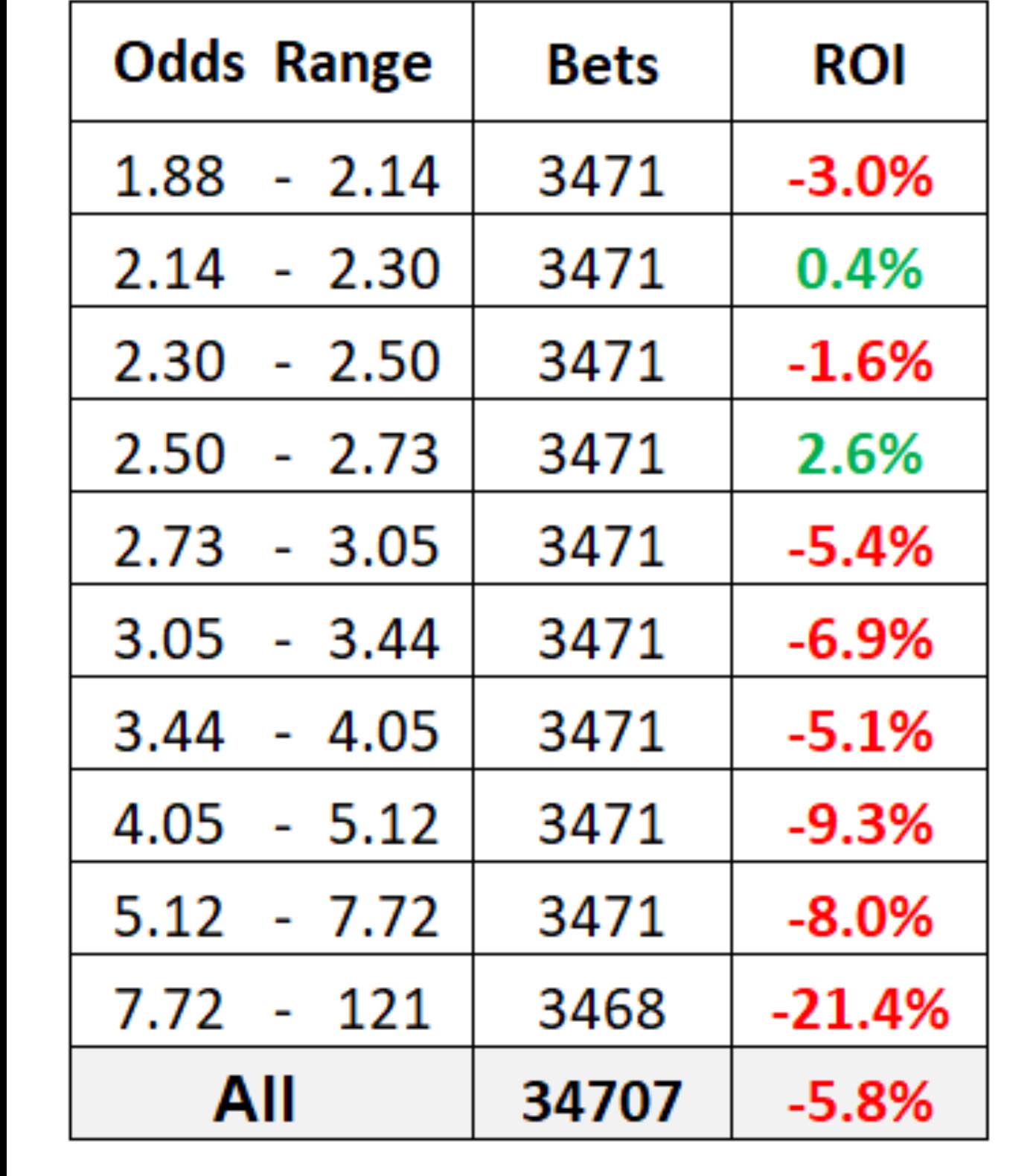
Filtering Underdog Markets
So if the performance of large price underdogs is actually decent – especially with exchange prices and a competitive commission model – then with a few filters this should present an effective tennis betting profit strategy. Tennis Tips UK analyst’s have delved deep into the data for this over the years and have developed multiple filters as to selectively use underdogs to obtain a positive yield.
Club members are the only ones to benefit from this advisory which delivered 115.80% ROI as of early 2024. However for those looking to develop their own tennis betting approach here is some inspiration.
The 1-2 selections per week sent to club members are filtered based on criteria like this (over seventeen factors in total) with extensive data to back them up across sharp bookmaker and exchanges.
Round Attainment Discrepancy
One research area for our team was how underdogs perform at different stages of events and types of tournaments. There is a clear trend suggested in the table below derived from extensive research. This could suggest a filter of avoiding underdogs in the early rounds but backing them as the event progresses to the later stages.
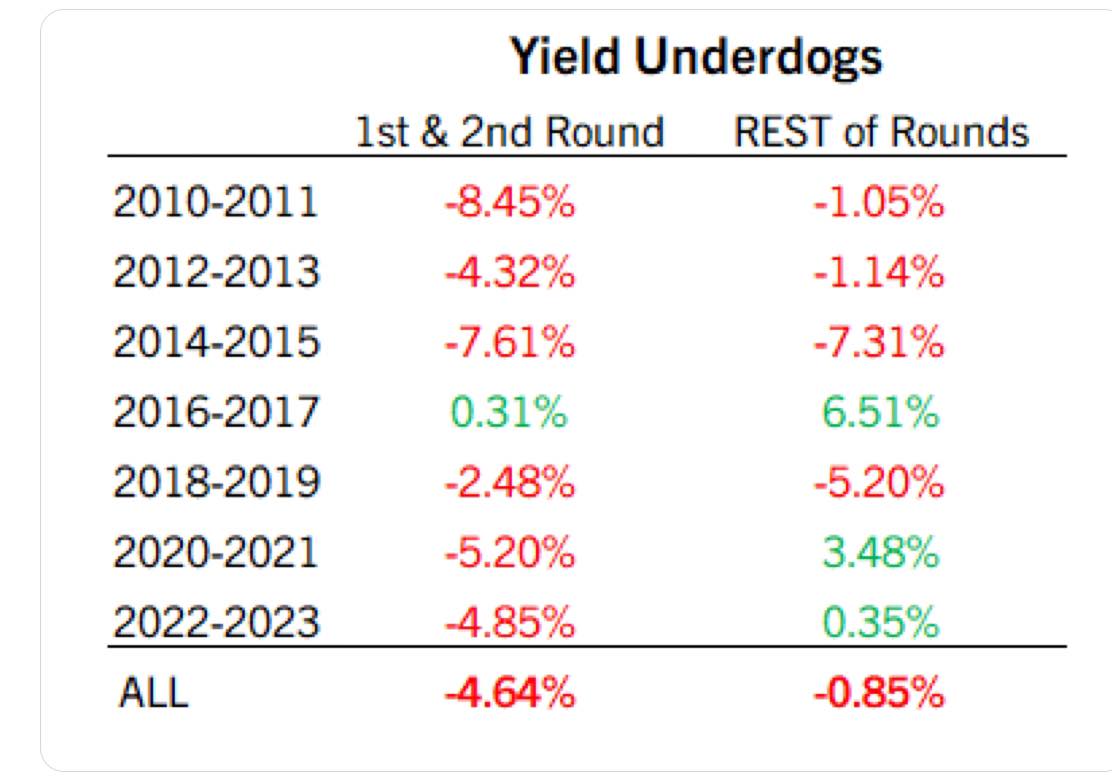
Player Ranking – Excluding Outliers
An area of research by Tennis Tips UK analysts has focused on the concept of only backing underdogs when they have a ranking below their opponent. This may sound like a given but there are occasions when underdogs are actually higher ranked but with exceptionally poor recent form or potential injury issues.
The idea with this theory is that only underdogs that would be expected to be priced that way are backed. Meaning the normal flow of money will back the favourite from recreational punters thinking it’s a formality for the bigger name player to progress.
This frequently leads to unjustified odds drifts for the underdog as bookmakers cover their lability on the favourite should they indeed win. Backing these selections once the drift has occurred could present +EV over a large sample size.
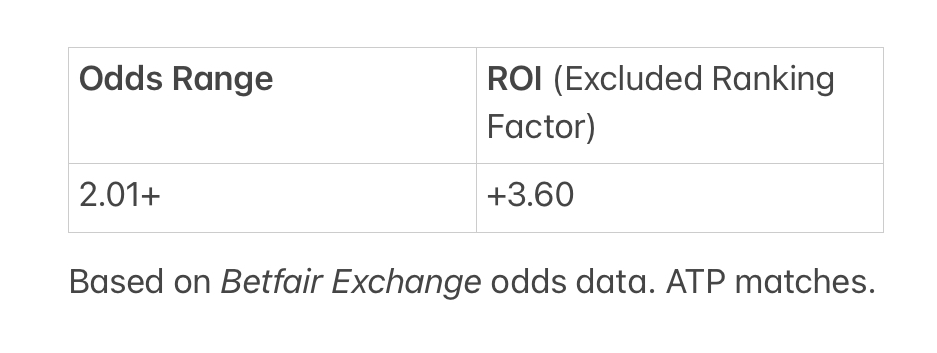
CONCLUSION: This thesis was approved as notable by our analysts and was integrated as a screening factor for club members from early 2024 onwards. There are of course additional factors and exclusions to this rule but it’s certainly worth additional research.
The significance of beating closing line odds
Sustained tennis profit is achieved through backing the correct prices/odds rather than the correct player. Every selection offers value at a certain threshold and the most informed choice isn’t worth backing when odds shorten too far. The closing line at sharp bookmakers and exchanges has an almost exact correlation with true probability so a good indicator of if underdog bets are good value hinges on if the price obtained exceeds the level at match commencement.
Tennis Tips UK analysts have researched this extensively and have applied filters for club member selections based on an increased probability the advised price represents a peak that late smart money into the market is likely to shorten. The tracking platform used for these club picks documents how effective the selections are at beating the closing price. This is referred to as ‘Avg Diff CO’ and is represented as a percentage.
Enhancing Risk / Reward Profile via Set Handicap
It’s daunting enough trying to pick big price match winners in tennis so surely backing them to win in straight sets is just a step too far? Well interestingly collated Tennis Tips UK data spanning 2013-present paints a different picture. In fact major underdogs win in straight sets (i.e -1.5 or -2.5 Set Handicap dependant on three or five set match format) far more frequently than most tennis punters would imagine.
Clearly this isn’t a universal rule and as always further filter criteria is required but often the straight sets outcome drifts to an unjustified price as money flows in to the match winner market for the firm favourite. Club members will notice this thesis integrated into selections occasionally when the margin of value from 2-0 or 3-0 (Set Betting) far exceeds the match winner money line.


